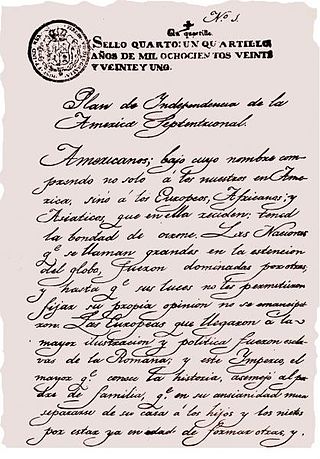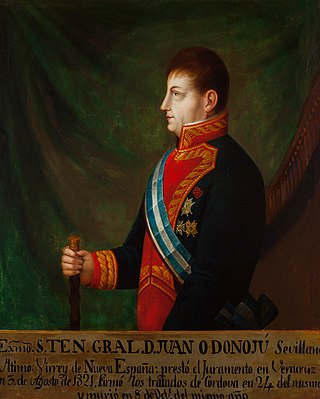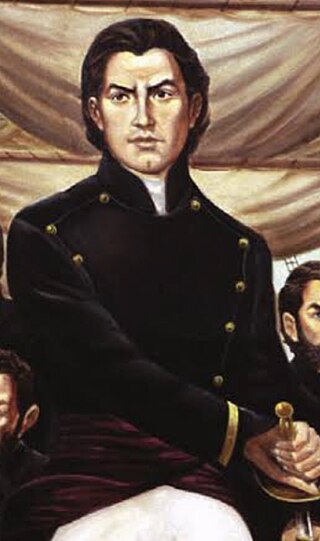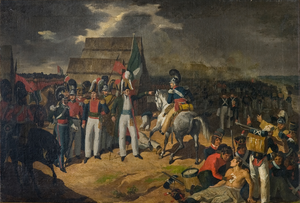
The Pastry War, also known as the first French intervention in Mexico or the first Franco-Mexican war (1838–1839), began in November 1838 with the naval blockade of some Mexican ports and the capture of the fortress of San Juan de Ulúa in the port of Veracruz by French forces sent by King Louis Philippe I. It ended in March 1839 with a British-brokered peace. The intervention followed many claims by French nationals of losses due to unrest in Mexico. This would be the first of two French invasions of Mexico; a second, larger intervention would take place in the 1860s.

San Juan de Ulúa, now known as Castle of San Juan de Ulúa, is a large complex of fortresses, prisons and one former palace on an island of the same name in the Gulf of Mexico overlooking the seaport of Veracruz, Mexico. Juan de Grijalva's 1518 expedition named the island. On March 30, 1519, Hernan Cortés met with Tendile and Pitalpitoque, emissaries from Moctezuma II's Aztec Empire.

Guadalupe Victoria, born José Miguel Ramón Adaucto Fernández y Félix, was a Mexican general and politician who fought for independence against the Spanish Empire in the Mexican War of Independence and after the adoption of the Constitution of 1824, was elected as the first president of the United Mexican States. He was a deputy in the Mexican Chamber of Deputies for Durango and a member of the Supreme Executive Power following the downfall of the First Mexican Empire, which was followed by the 1824 Constitution and his presidency. He later served as Governor of Puebla.

The Plan of Iguala, also known as The Plan of the Three Guarantees or Act of Independence of North America, was a revolutionary proclamation promulgated on 24 February 1821, in the final stage of the Mexican War of Independence from Spain. The Plan stated that Mexico was to become a constitutional monarchy, whose sole official religion would be Roman Catholicism, in which both the Peninsulares and the Americanos would enjoy equal political and social rights. It took its name from the city of Iguala in the modern-day state of Guerrero.

Veracruz, also known as Heroica Veracruz, is a major port city and municipal seat for the surrounding municipality of Veracruz on the Gulf of Mexico and the most populous city in the Mexican state of Veracruz. The city is located along the coast in the central part of the state, 90 km (56 mi) southeast of the state capital Xalapa.

Juan José Ruiz de Apodaca y Eliza, 1st Count of Venadito, OIC, OSH, KOC was a Spanish Navy officer, nobleman and colonial administrator who served as the viceroy of New Spain from 20 September 1816 to 5 July 1821 during the Mexican War of Independence.

Miguel Francisco Barragán Andrade was a Mexican soldier and politician who served as interim president of Mexico in 1836. He had previously served as Governor of Veracruz, and gained national fame for the capture of the Fortress of San Juan de Ulúa in 1824, through which Spanish military presence was finally expelled from Mexico.

Juan José Rafael Teodomiro de O'Donojú y O'Ryan was a Spanish-Irish military officer, diplomat and Viceroy of New Spain (Mexico) from 21 July 1821 to 28 September 1821 during the Mexican War of Independence. He was the last Viceroy of New Spain.

Pedro de Castro y Figueroa y Salazar, 1st Duke of la Conquista, 1st Marquess of Gracia Real, KOS, OSJ was a Spanish military officer and viceroy of New Spain.

Roberto Simpson Winthrop, was a sailor of English origin, nationalized Chilean, who made a career in the Chilean Navy from 1818 and reached the rank of rear-admiral in 1852. Distinguished himself during the Spanish American wars of independence and the War of the Confederation. He was also founder of the Simpson family in Chile, initiator of the first hydrographic works in the country, senator and diplomat.
José María Coppinger was a Spanish soldier who served in the infantry of the Royal Spanish Army (Ejército de Tierra) and governed East Florida (1816–1821) and several areas in Cuba including Pinar Del Río, Bayamo, the Cuatro Villas and Trinidad at various times between 1801 and 1834. He was also a member of the Royal and Military Order of Saint Ferdinand and San Hermenegildo.
In attempts to retain or re-assert control over its colonies in America, the Spanish Empire deployed several expeditionary forces during and after the Spanish American wars of independence. The largest of these forces, known as "the expeditionary army of Costa Firme", and consisting of over 10,000 troops under General Morillo, undertook the Spanish reconquest of New Granada (1815–16). Forces were also sent to New Spain between 1812 and 1817. Later, after Mexican independence in 1821, a Spanish garrison was sent from Cuba to occupy Spain's last Mexican outpost, the fortress of San Juan de Ulúa; this force remained there until surrendering in 1825. Finally, a force under Isidro Barradas Valdés attempted to regain control of Mexico in 1829.

The nations of Cuba and Mexico have had uninterrupted diplomatic relations since their establishment in 1902. Both nations are members of the Association of Caribbean States, Community of Latin American and Caribbean States, Latin American Integration Association, Organization of Ibero-American States, and the United Nations.
In the history of Mexico, the Plan of Veracruz was a call to revolt against Emperor of Mexico Augustín de Iturbide, proclaimed by Antonio Lopez de Santa Anna at the port of Mexico on December 2, 1822. It was ratified on December 6.
In the history of Mexico, the Plan of Veracruz was a proclamation released on January 2, 1832, by the military garrison of Veracruz. The initial goal was simply to remove unpopular ministers from the cabinet of President Anastasio Bustamante, but later expanded into a year-long civil war within the First Mexican Republic that ended with the ousting of Bustamente and the recognition of Manuel Gómez Pedraza as president.
The Black Eagle Party, also known as the Great Legion of the Black Eagle, was a Mexican pro-independence Masonic lodge opposing the Spaniards and the intervention of the Catholic Church in society. The party was established on May 30, 1823, by Guadalupe Victoria and Simón de Chávez in Puente del Rey, Veracruz, Mexico. The organization's main goal was facilitating the freedom of the Americas. The organization was considered to be the first political party founded in independent Mexico before later merging into the Liberal Party.

Pedro Sáinz de Baranda y Borreiro was a naval officer, industrialist, and liberal politician who founded the Mexican Navy and led the naval blockade of Veracruz, which ended with the Spanish surrendering San Juan de Ulua Fort in 1825, the last portion of Mexican territory still in Spanish hands. This event is recognized as the culmination of the Mexican War of Independence.
The Battle of Mariel was a small-scale naval engagement fought between the First Mexican Republic and the Spanish Empire near the Cuban port town of Mariel. The battle resulted in a Spanish victory, with the Mexican navy losing the brig Guerrero.

The Battle of Tampico, also referred to as the Barradas Expedition, was a series of military engagements between the First Mexican Republic and Spain. Fought from July to September 1829 and culminating on 11 September, the battle was part of several Spanish attempts to re-establish control over Mexico. The battle was a major victory for Mexico and marked the final major battle between Spain and its former colony.
Francisco Fernández y Félix, better known as Francisco Victoria, was an insurgent of the Mexican War of Independence. Being a republican and federalist ideologue, he fought against the imperialist regime of Agustín de Iturbide and the centralist regime of Anastasio Bustamante.















